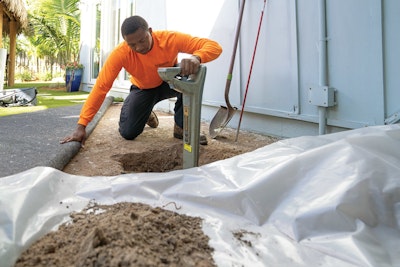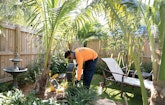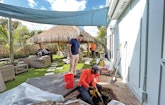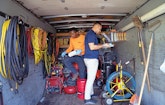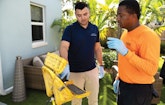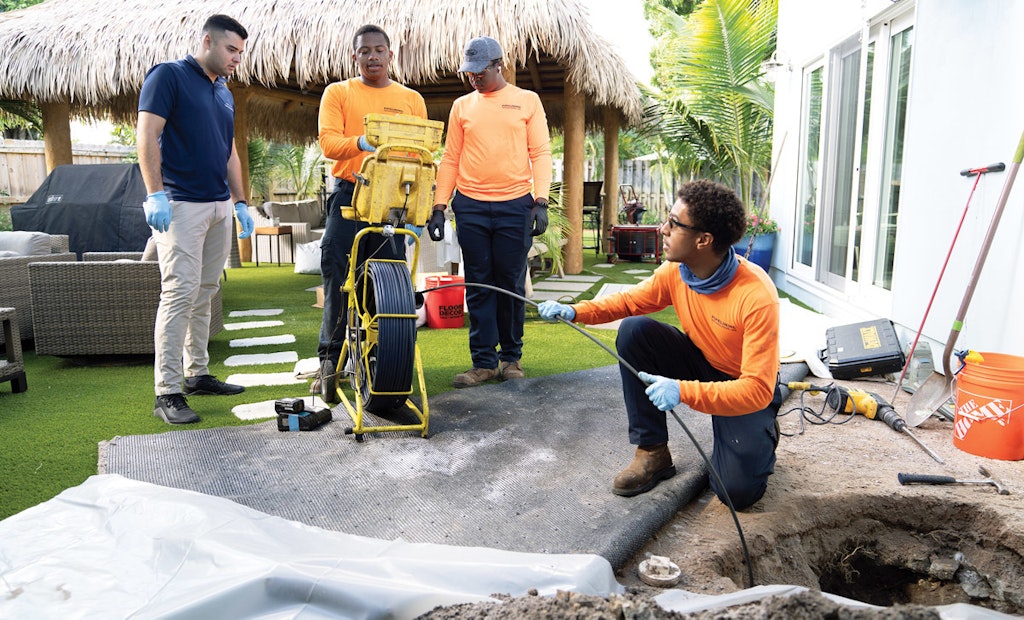
Pipelining Technologies operations manager Loren Wilson, team leader Rashard Turner, and technicians Jalon Jones and Micah Pena (from left) inspect a pipe before a lining job.
Interested in Relining/Rehab?
Get Relining/Rehab articles, news and videos right in your inbox! Sign up now.
Relining/Rehab + Get AlertsAnswering the door when opportunity knocks may be a cliché, but it aptly describes what spurred Michael Wilson to establish Pipelining Technologies, a trenchless pipeline rehabilitation company, back in 2004.
At the time, Wilson owned a plumbing company called Wilson Plumbing, based in West Palm Beach, Florida. While at a trade show, he learned about pipe lining technology, which then was in its infancy in the United States.
“He was very intrigued by it and saw huge potential in our market for this kind of technology,” says Loren Wilson, Michael Wilson’s son and the company’s operations manager.
The proverbial knock on the door arrived in the form of a phone call from a prestigious resort in Palm Beach that was having issues with leaking sewer lines that ran under the resort’s golf course and pool.
“Excavating to replace the pipes was problematic because of the high water table in Florida and digging up a golf course and below a pool would be extremely disruptive,” Wilsons says. “So it was a perfect application for pipe lining technology.
“I was 10 years old at the time and still have photos of myself on that job, which led us into full-scale pipe lining.”
Time to specialize
After completing that project, the elder Wilson was so convinced about the great future potential of pipe lining that he decided to jettison his plumbing services and focus on trenchless pipe rehab instead. And so Pipelining Technologies was born.
Today, the company generates millions of dollars a year in revenue and employs 40 people, compared to four when the company was founded. Its primary service is lining vertical stack pipes in condominiums.
“We’ve lined stack pipes in 25-story buildings with one solid liner, instead of leaving joints at every floor that could eventually fail or leak,” Wilson says, noting that the company mostly uses MAX SuperFlex liners from MaxLiner USA for long, straight runs of pipe.
If vertical stacks have multiple offsets, the business uses the Brawoliner product from Germany-based Brawo Systems (supplied by Apex CIPP Solutions), which is a more flexible liner that transitions well inside pipes with varying diameters.
“We like to have as many tools in the toolbox as possible to fit all applications,” Wilson says.
In the ensuing years, the company developed a reputation for investing in cutting-edge technology for everything from pipe lining to pipeline inspections to robotic tools that do everything from reinstating sewer lines to grinding out obstructions.
And as technologies advanced, Michael Wilson left no stone unturned in his search for the latest and greatest tools — a quest that led him to attend trade shows in Europe as well as the United States. It’s not that he disliked American technology; at the time, European companies were the only ones building products that matched his father’s needs, Wilson says.
“A lot of the robotic tools he wanted at the time were made only in Europe,” he explains. A good example is the five DC Super Flex reinstatement machines the company owns, made by Dancutter, a Denmark manufacturer.
“At a WWETT (Water & Wastewater Equipment, Treatment & Transport) Show, the owner of Dancutter asked us to come and visit his facility, and after that, we sent two technicians there for training,” Wilson says. “Then we heard about other European trade shows and that’s how the snowball started rolling.”
Small-line solution
For pipe lining, the Brawoliner represented the most suitable solution for rehabbing the small, 2-inch drainlines prevalent in Florida. It’s common for these drainlines to be buried in homes’ concrete-slab foundations, Wilson explains.
“Many homes have bathrooms on one side of the house and a kitchen and laundry facilities on the other side. So there are a lot of bends in the lines.
“We almost gave up on the market for lining 2-inch pipes because there wasn’t anything available, which left us with the option of breaking open floors to replace pipes. But then we found Brawoliner, which really shines in the 2-inch market.”
Brawoliners are made from a special knitted fabric that makes them very flexible, an attribute that works great in lines with multiple 90-degree bends, Wilson says.
“With Brawoliners, we can make a small opening in drywall or even line from the roof through a stack pipe because it’s a little undersized, which allows it to direct itself through bends in 2-inch pipes and wrap around fittings. It makes for a nice, smooth, finished product, without any wrinkles.”
Furthermore, installations go faster because there’s no need to use a calibration tube to keep the pipe conformed to the host pipe as it cures. Instead, the liners are wrapped inside a Saran-wrap-like foil, or membrane, which makes it airtight, he says.
“We just clamp shut the end of the liner and inflate it with an air compressor, which keeps it pressed against the host pipe. The air pressure effectively acts as a calibration tube.”
Productivity investments
Over the years, the company has built a large inventory of equipment to better serve customers. That roster includes an XR2 vacuum trailer made by Vermeer Corp.; three 4018 trailer jetters from US Jetting (4,000 psi at 18 gpm) and two E Series trailer jetters from Harben (4,000 psi at 18 gpm).
To inspect pipes, the company relies on nearly two dozen Pearpoint push cameras; three Agilios push cameras from IPEK International GmbH in Germany, used primarily for inspecting vertical stack pipes; one push camera made by IBOS a.s. in the Czech Republic; six MiniFlex cameras from Camtronics BV in The Netherlands, for smaller-diameter pipe; and one Viper push camera that attaches to a jetter hose and is made by Envirobot in Germany.
For pipe lining projects, the company relies on two inversion drums made by Perma-Liner Industries and Sacpro AB in Sweden; Tee-liners made by Repiper AB, another Swedish company; and felt liners from RSM Lining Supplies.
“The Tee-liners allow us to line leaking fittings without opening up walls,” Wilson says.
For point repairs in pipelines, Pipelining Technologies uses systems from Trelleborg Pipe Seals and HammerHead Trenchless.
The company also owns Maxi and Mini Miller drain machines from Picote Solutions; a Picote Brush Coating System, which lines pipes with thins layers of epoxy; four drum cable machines from General Pipe Cleaners; eight drum cable machines from RIDGID and one RIDGID K-60SP sectional drain machine.
Keys to success
One critical success factor was Michael Wilson’s emphasis on directing profits back into the company and investing in advanced technologies. That enabled the company to do larger and more complex projects that competitors couldn’t handle for lack of suitable equipment; plus it helped the company establish a stronghold in a lucrative market niche, Wilson says.
“Instead of branching out with plumbing and lining divisions, we narrowed our focus to just pipe lining because of the huge potential,” he explains. “And because pipe lining is so different from plumbing, we found it more beneficial to have our guys focus just on pipe lining.
“As a result we feel like our guys are the best in the southern Florida market because that’s all they do.”
Wilson also credits a bonus program that motivates workers to follow safety protocols, wear proper personal protection gear, do required paperwork thoroughly and so forth.
“If they do all these things, they get a cash bonus at the end of each month,” he says. “If they violate rules, it decreases their bonus payment. And the longer you’re here, the higher the available incentives.”
The program has been very effective at boosting on-the-job safety and ensuring that managers file daily work reports.
“Things changed 180 degrees,” Wilson says.
Training first
Looking ahead, Wilson says the company plans to continue its pattern of steady and consistent growth in order to avoid the pitfalls that often come with rapid growth, such as decreases in quality control and customer service.
Management also plans to continue its emphasis on employee training.
“We won’t make an employee a team leader until they have three years of experience,” Wilson says. “In this industry, there are a lot of things that can go wrong on jobs, so we want our guys trained as well as possible.”
Furthermore, the company also will continue to invest in new, productivity-enhancing technology. For example, the business likely will buy a UV-light-cured pipe-lining system in 2022, which will allow crews to perform long lining runs in larger-diameter pipes.
“We just used a UV-light system to do a 300-foot-long lining run in 8- to 10-inch-diameter cast iron pipe running under a condominium,” Wilson says. “It cured in 3 1/2 hours and we cut in reinstatements the next day, which is very fast for such a long run and this level of difficulty.
“The bottom line is we always want to have the tools and the know-how to accomplish whatever our customers need.”
